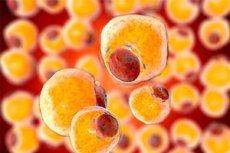
了解脂肪组织的形成和功能对于对抗肥胖及相关代谢疾病至关重要。然而,脂肪组织(或称体脂)在体内不同位置的表现有所不同。
以肠系膜为例:它是由一大块围裙状的脂肪组织,悬挂于胃部,覆盖腹膜内的器官,例如胃和肠。它不仅储存脂肪,还在免疫调节和组织再生中发挥作用。
肠系膜脂肪组织与“苹果”形体相关,当脂肪库显著扩张时,就会出现这种体形,从而增加代谢性疾病的风险。这种扩张并非源于新脂肪细胞的形成(这一过程称为脂肪生成),而主要是通过现有细胞的增大(这一过程称为肥大)。这可能导致慢性炎症和胰岛素抵抗。
与皮下脂肪相比,肠系膜脂肪在热量过剩的情况下形成新脂肪细胞的能力有限,这一点目前仍不清楚。如今,由洛桑联邦理工学院(EPFL)Bart Deplancke 教授领导的科学家们在人类肠系膜脂肪中发现了一种抑制脂肪生成的细胞群。这项发表在《细胞代谢》杂志上的发现,为肠系膜脂肪启动脂肪生成的能力有限提供了新的见解,对肥胖管理具有重要意义。
研究人员利用先进的单细胞RNA测序技术分析了来自不同人体脂肪库的细胞,分离出不同的细胞亚群,并测试它们转化为新脂肪细胞的能力。这项研究得到了包括CHUV在内的多家医疗机构的支持,涉及30多名人类捐赠者,以详细比较不同的脂肪位置。
该方法鉴定出肠系膜脂肪中存在的一群细胞,这可能是解释其独特特性的关键。这些细胞被称为间皮细胞,通常排列在人体某些内部腔体上,形成一层保护层。
在这些间皮细胞中,一些细胞奇怪地转变为更接近间充质细胞的细胞,而间充质细胞可以发育成各种细胞类型,包括脂肪细胞。这种细胞状态之间的动态转变可能是这些细胞影响肠系膜脂肪组织脂肪形成潜力的关键机制。
研究表明,这些细胞的间充质样特性与增强的调节微环境的能力相关,从而提供了一种限制脂肪组织扩张的调节机制。通过在这两种状态之间切换,这些细胞可以影响肠系膜脂肪库的整体代谢行为及其在不引起代谢并发症的情况下积累脂肪的能力。
重要的是,我们还至少部分鉴定了新的肠系膜细胞群影响脂肪生成的分子机制。具体来说,这些细胞高水平表达胰岛素样生长因子结合蛋白2 [IGFBP2](一种已知可抑制脂肪生成的蛋白质),并将该蛋白质分泌到细胞微环境中。这反过来又靶向邻近脂肪干细胞和祖细胞上的特定受体,有效阻止它们发育成成熟的脂肪细胞。
该研究的主要作者之一Radiana Ferrero(EPFL)表示:“这些发现对于理解和潜在控制代谢性不健康肥胖具有深远意义,”另一位首席研究员Pernilla Rainer(EPFL)解释说。“了解肠系膜脂肪具有限制脂肪细胞形成的内在机制,可能有助于开发调节这一自然过程的新疗法。此外,这项研究也为靶向治疗开辟了可能性,这种疗法可以调节特定脂肪库的行为。”

